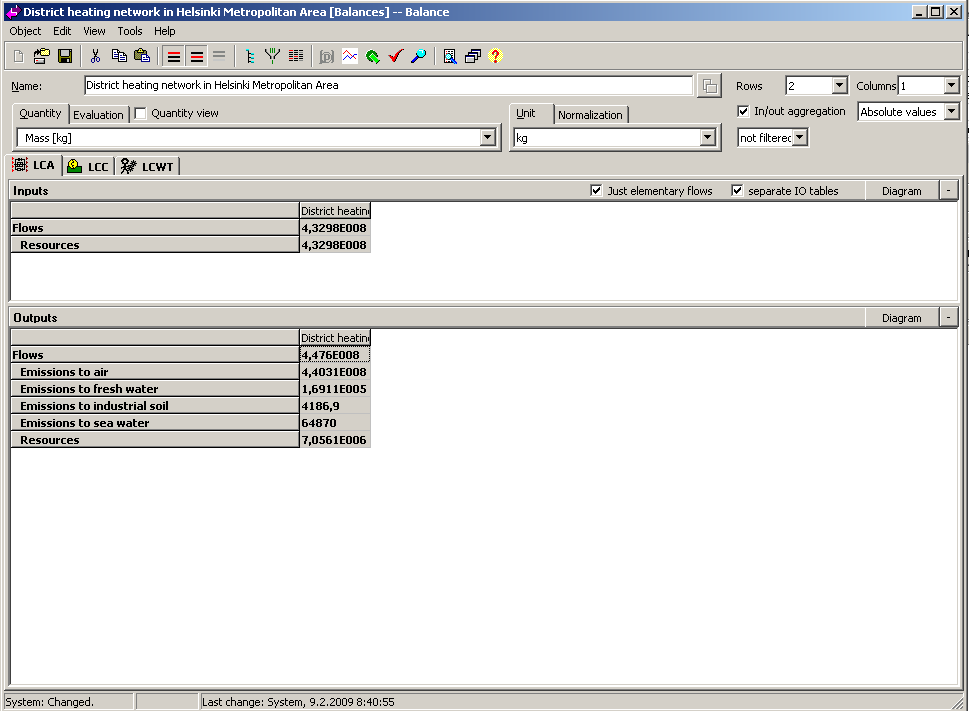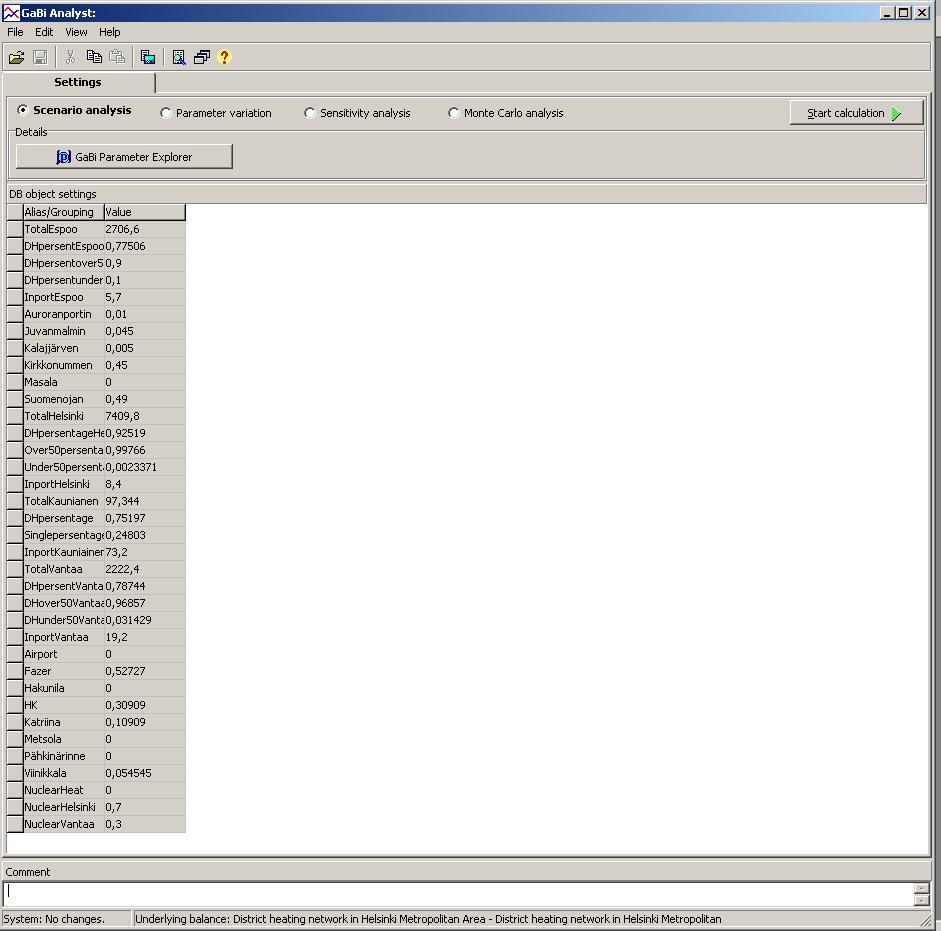Gabi 4.3 - life cycle assessment software: Difference between revisions
mNo edit summary |
mNo edit summary |
||
| Line 5: | Line 5: | ||
Heres a picture of just activated database and all the variables that can be modified. | Heres a picture of just activated database and all the variables that can be modified. | ||
[[Image:Gabi.JPG]] | [[Image:Gabi.JPG]] | ||
After this it is best to create or activate exiting project by clicking "projects" folder and creating new project or choosing already exiting project from the database. Activating project will save all the changes to plans and other processes which are affected. Without activating project you would have to close and activate the database everytime you make changes to make changes to be affected. | After this it is best to create or activate exiting project by clicking "projects" folder and creating new project or choosing already exiting project from the database. Activating project will save all the changes to plans and other processes which are affected. Without activating project you would have to close and activate the database everytime you make changes to make changes to be affected. | ||
| Line 16: | Line 17: | ||
[[Image:Vantaaplan.JPG]] | [[Image:Vantaaplan.JPG]] | ||
[[Image:Under50MWplantsVantaa.JPG]] | [[Image:Under50MWplantsVantaa.JPG]] | ||
Helsinki, Espoo and Kauniainen plans have also similar of sub plans, only the amounts of plants and heat production distribution are different. All the variables are bound to heat demand in each area by global parameters. So global when global parameters are changed will also emissions and heat loads change according to the change. Global parameters can be added in the start list global parameters section. I created global parameters for each city in the area. Heres a list of all global parameters I made. | Helsinki, Espoo and Kauniainen plans have also similar of sub plans, only the amounts of plants and heat production distribution are different. All the variables are bound to heat demand in each area by global parameters. So global when global parameters are changed will also emissions and heat loads change according to the change. Global parameters can be added in the start list global parameters section. I created global parameters for each city in the area. Heres a list of all global parameters I made. | ||
[[Image:Globals.JPG]] | [[Image:Globals.JPG]] | ||
Balance of the plan will tell how much outputs and inputs the plan has. In other words how much resources and fuel is used to create energy and emissions. For calculating balance, you need to press balance button which is over each plan in the icon row. Heres picture of my main plan. | Balance of the plan will tell how much outputs and inputs the plan has. In other words how much resources and fuel is used to create energy and emissions. For calculating balance, you need to press balance button which is over each plan in the icon row. Heres picture of my main plan. | ||
| Line 24: | Line 27: | ||
[[Image:Balance.PNG]] | [[Image:Balance.PNG]] | ||
For comparing different scenarios, you need to press Gabi Analyst button which is over the balance sheet in the icon row. Here you can modify parameters and in my project this would allow to handle every possible case for under 50 MW Helsinki Metropolitan Area district heating plants to year 2020. | For comparing different scenarios, you need to press Gabi Analyst button which is over the balance sheet in the icon row. Here you can modify parameters and in my project this would allow to handle every possible case for under 50 MW Helsinki Metropolitan Area district heating plants to year 2020. | ||
Revision as of 06:58, 9 February 2009
This page is a encyclopedia article.
The page identifier is Op_en2788 |
|---|
| Moderator:Nobody (see all) Click here to sign up. |
|
|
| Upload data
|
Gabi 4.3 software is versatile program which can be used for life cycle assessment and cost analysis. I used it to model forming emissions from small scale thermal energy production and domestic combustions in Helsinki Metropolitan Area.
When you open Gabi, you will see databases which are on use. By activating database you will get all the balances, plans, processes, flows, quantities, units, projects and indicators to your use which are in that particular database.
Heres a picture of just activated database and all the variables that can be modified.
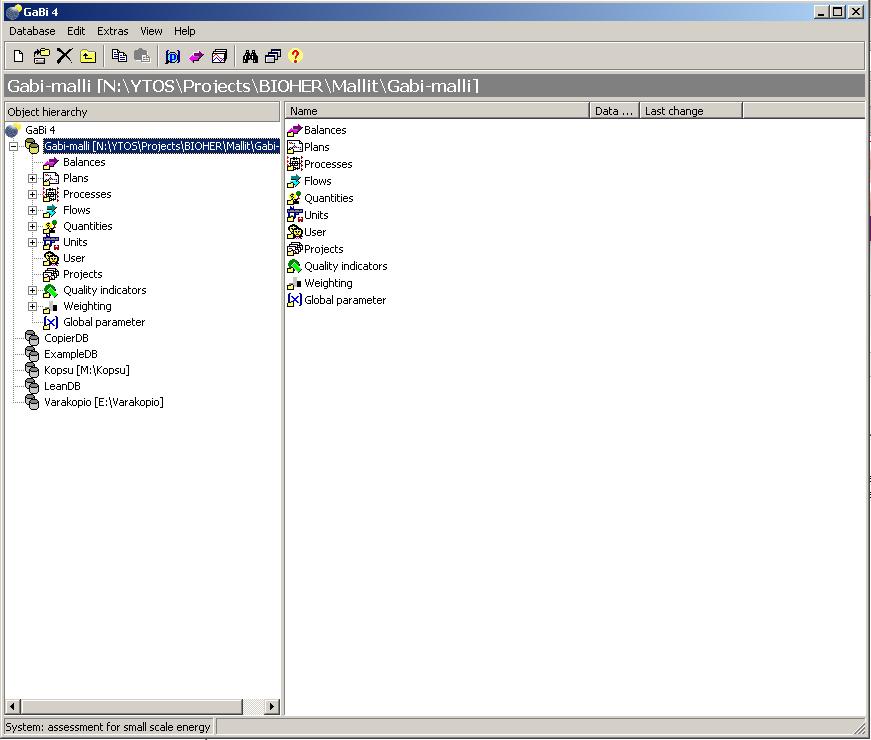
After this it is best to create or activate exiting project by clicking "projects" folder and creating new project or choosing already exiting project from the database. Activating project will save all the changes to plans and other processes which are affected. Without activating project you would have to close and activate the database everytime you make changes to make changes to be affected.
Project usually starts up by creating plan, which is basically one part or whole chain of singular processes of the project. Plans can also contain sub plans. Sub plans are used for making the model simpler and understandable. Result of these linked processes and plans, whole production chain should be modeled and every flow in the chain should be in it.
When the whole model is ready the program will calculate balance for the model, which tells what kind of inputs and output the whole process has. The results are as reliable as every singular process is, so every single process has to modeled as good as can to match the real process.
I started my assessment for small scale thermal energy production in Helsinki Metropolitan Area project by making Main plan folder for Helsinki Metropolitan Area an in it I put four sub plans for each city in the area (Helsinki, Vantaa, Espoo and Kauniainen). These sub plans consist singular processes as heat demand in the particular area, which determines the heating need for district heating and single-family heating. Because I concentrated in small scale district heating plants and single-family heating, I created single process for over 50 MW district heating plants, which did not have any other outputs than the energy, so they did not have any affect on emissions which are in balance of the model. The only emissions are caused by the small scale district heating plants and single-family heating methods. In addition I added 6th possible nuclear plant process which might come to Loviisa when its thermal heat might be joined to district heating network and thus reducing the heat produced by combustion plants. Heres a pictures of my model, fist picture of main plan, second is Vantaas district heating network plan and third is under 50 MW plants in Vantaa plan.
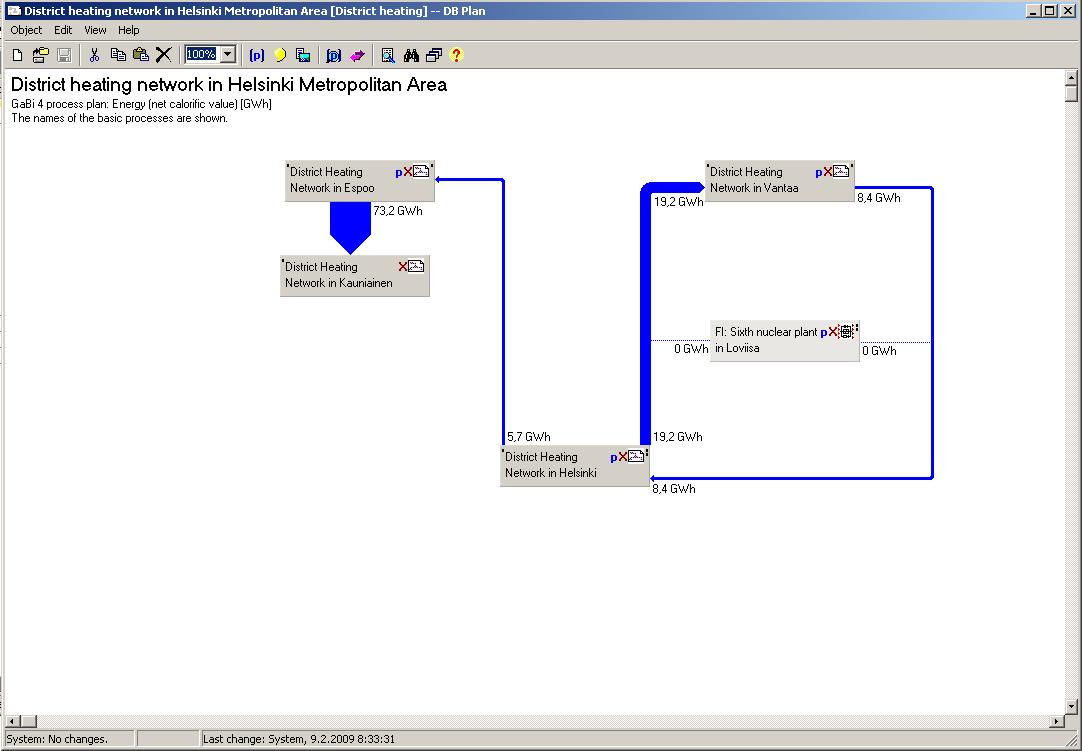
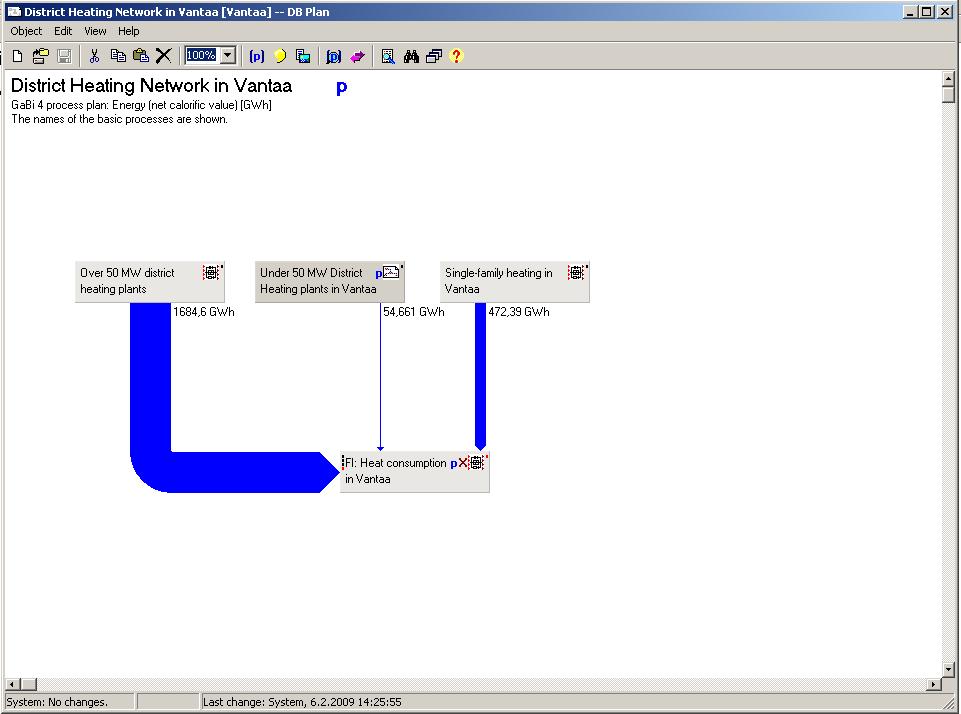
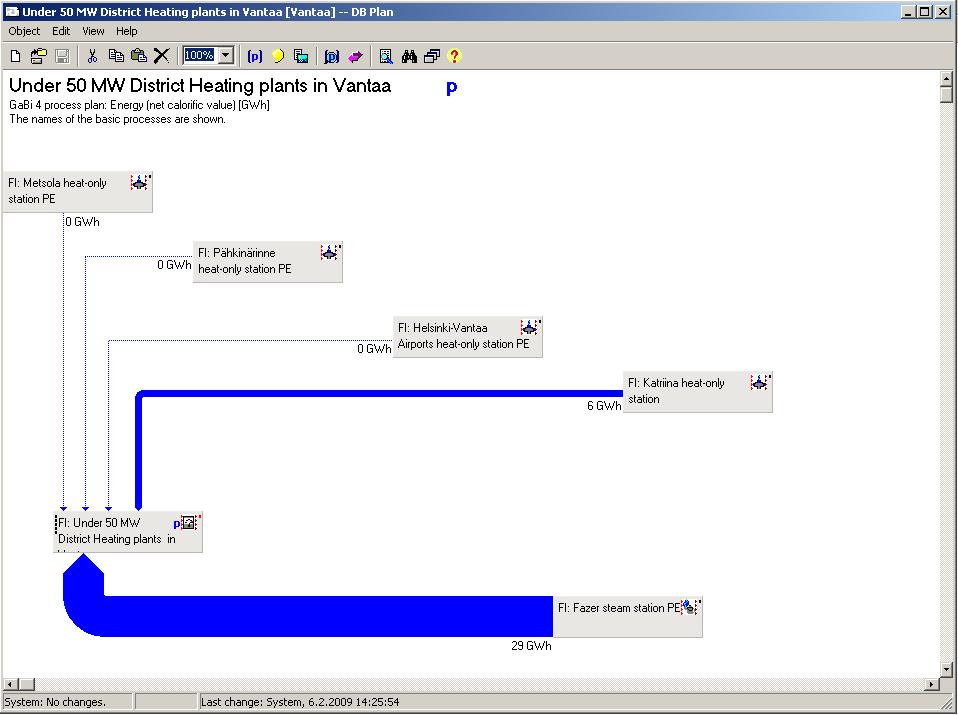
Helsinki, Espoo and Kauniainen plans have also similar of sub plans, only the amounts of plants and heat production distribution are different. All the variables are bound to heat demand in each area by global parameters. So global when global parameters are changed will also emissions and heat loads change according to the change. Global parameters can be added in the start list global parameters section. I created global parameters for each city in the area. Heres a list of all global parameters I made.
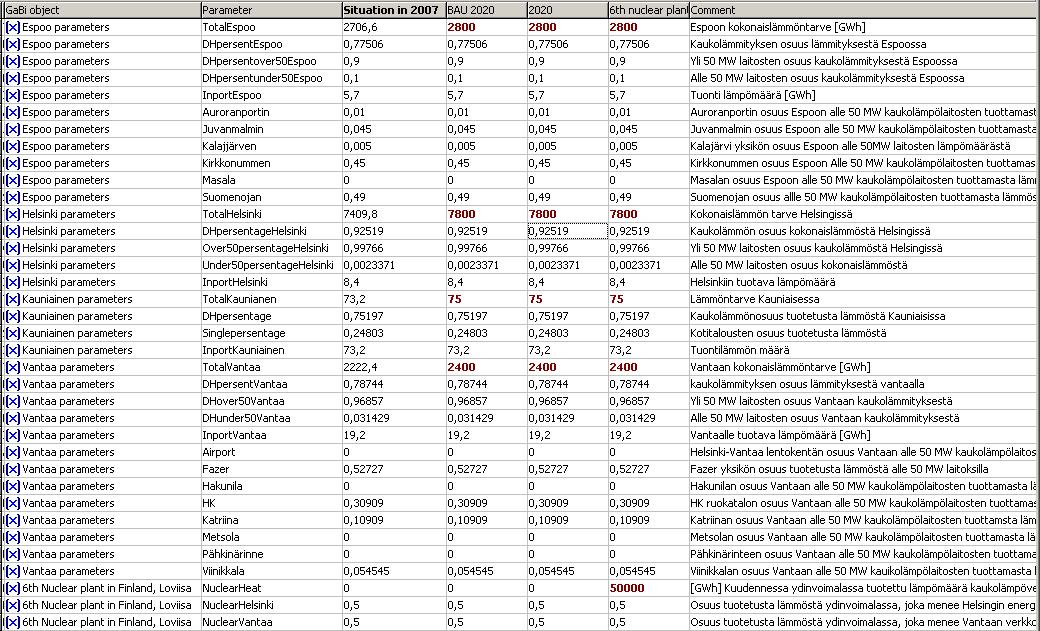
Balance of the plan will tell how much outputs and inputs the plan has. In other words how much resources and fuel is used to create energy and emissions. For calculating balance, you need to press balance button which is over each plan in the icon row. Heres picture of my main plan.
->
For comparing different scenarios, you need to press Gabi Analyst button which is over the balance sheet in the icon row. Here you can modify parameters and in my project this would allow to handle every possible case for under 50 MW Helsinki Metropolitan Area district heating plants to year 2020.
->
